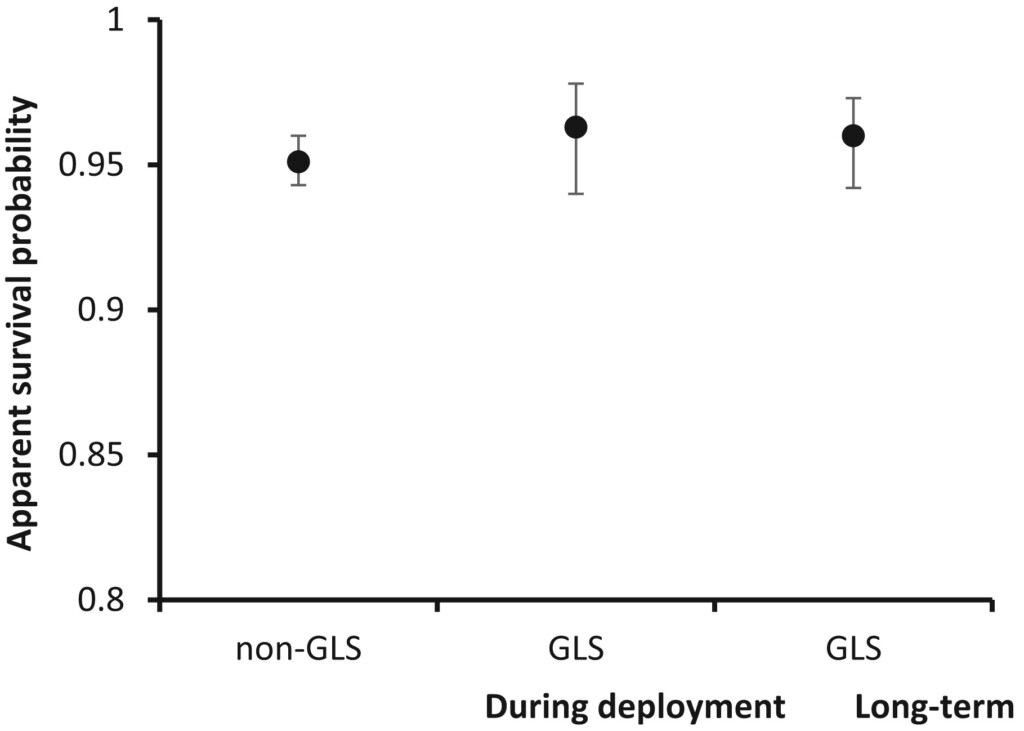
LINKED PAPER
No detectable effect of geolocator deployment on the short‐or long‐term apparent survival of a tropical seabird.. Nicoll, M. A., Cole, N. C., Horswill, C., Jones, C. G., Ratcliffe, N., Ruhomaun, K., Tatayah, V. & Norris, K. 2022. IBIS. DOI: 10.1111/ibi.13094. VIEW
Biologging devices, such as geolocators, can provide important information about the behaviour and life history of birds. However, these small loggers could affect the survival probability or breeding success of tagged individuals. Indeed, extensive analyses of multiple studies have found negative effects in some bird species (Geen et al. 2019). In seabirds, for example, two out of 14 studies reported a negative impact of leg-mounted tags on return rates (Kürten et al. 2019). It is thus important to assess the effects of geolocators before employing them on a larger scale.
Round Island Petrels
Malcolm Nicoll and his colleagues took advantage of a long-term mark-recapture dataset in combination with a geolocator-tagging programme for the Trindade Petrel (Pterodroma arminjoniana). Between 2009 and 2012, almost 400 petrels were equipped with a geolocator on their left tarsus. The survival probability of these tagged individuals could be compared with the entire population on Round Island (Mauritius) which has been monitored since 1993. Survival analyses revealed that “adult apparent survival probabilities were not negative affected either during GLS [i.e. global location sensing] deployment or in the long-term.” In other words, the geolocators did not impact the survival probability of the petrels

Figure 1. Survival analyses showed no detectable differences in apparent survival between tagged and non-tagged petrels.
Conservation
This finding is obviously good news for the use of geolocators in ornithological research. The authors highlight that the absence of a tag-effect is probably due to its small size. The geolocators on the Trindade Petrels weighed less than 1% of their body mass, far below the advised threshold of 3% (Bodey et al. 2018). This information can be used to equip more seabird species with geolocators, providing important insights into the behaviour and life history of these birds. These insights can consequently inform evidence-based conservation strategies to protect threatened species (Rodríguez et al. 2019). Conservationists can acquire crucial information while the birds are not affected by the geolocators.
References
Bodey, T.W., Cleasby, I.R., Bell, F., Parr, N., Schultz, A., Votier, S.C. & Bearhop, S. (2018). A phylogenetically controlled meta-analysis of biologging device effects on birds: Deleterious effects and a call for more standardized reporting of study data. Methods in Ecology and Evolution 9: 946–955. VIEW
Geen, G.R., Robinson, R.A. & Baillie, S.R. (2019). Effects of tracking devices on individual birds – A review of the evidence. Journal of Avian Biology 50. VIEW
Kürten, N., Vedder, O., González-Solís, J., Schmaljohann, H. & Bouwhuis, S. (2019). No detectable effect of light-level geolocators on the behaviour and fitness of a long-distance migratory seabird. Journal of Ornithology 160: 1087–1095. VIEW
Rodríguez, A., Arcos, J.M., Bretagnolle, V., Dias, M.P., Holmes, N.D., Louzao, M., Provencher, J., Raine, A.F., Ramírez, F., Rodríguez, B., Ronconi, R.A., Taylor, R.S., Bonnaud, E., Borrelle, S.B., Cortés, V., Descamps, S., Friesen, V.L., Genovart, M., Hedd, A., Hodum, P., Humphries, G.R.W., le Corre, M., Lebarbenchon, C., Martin, R., Melvin, E.F., Montevecchi, W.A., Pinet, P., Pollet, I.L., Ramos, R., Russell, J.C., Ryan, P.G., Sanz-Aguilar, A., Spatz, D.R., Travers, M., Votier, S.C., Wanless, R.M., Woehler, E. & Chiaradia, A. (2019). Future directions in conservation research on petrels and shearwaters. Frontiers in Marine Science 6: 1–27. VIEW
Image credits
Top right: Trindade Petrel (Pterodroma arminjoniana) | Pablo Caceres Contreras | CC BY-SA 2.0 Flickr
Blog posts express the views of the individual author(s) and not those of the BOU.
If you want to write about your research in #theBOUblog, then please see here




